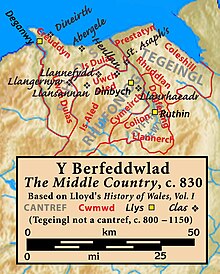Perfeddwlad
Perfeddwlad (also called Berfeddwlad; Welsh for The Middle Country ), also called Four Cantrefi or Gwynedd Is Conwy , is the historical name for a region in Northeast Wales . The area stretched between the Conwy and Dee rivers and was divided into the four Cantrefi Rhos , Rhufoniog , Dyffryn Clwyd and Tegeingl .
Historically Perfeddwlad belonged to the sphere of influence of the Kingdom of Gwynedd . Due to its border location with the Anglo-Saxon Kingdom of Mercien , it was the target of raids and attempts at conquest by the Anglo-Saxons for centuries . The south bordering Welsh Kingdom of Powys also claimed parts of the area. After 1071 the Normans tried to conquer the coastal areas from Chester , but after the failed campaign of King Henry II against Gwynedd in 1165 , the region fell back to Gwynedd. The attempts at conquest under King Johann Ohneland ultimately failed. Only after the death of Prince Llywelyn from Iorwerthof Gwynedd, the English King Henry III. recapture the region for England in 1141. In the Treaty of Woodstock , the princes of Gwynedd had to recognize the conquests in 1247, and to secure his conquests the English king built the mighty castles of Deganwy and Dyserth . 1254 transferred Heinrich III. his son Eduard extensive areas, which also included the county of Chester with Perfeddwlad. Welsh resistance rose against the strict English administration by Geoffrey de Langley . When the seventeen-year-old Edward showed no sympathy for the concerns of the Welsh people during a visit to the region in 1256, the Welsh nobles turned to Llywelyn ap Gruffydd , the prince of Gwynedd, who conquered the region within a week in November 1256 . In 1263 the isolated castles of Dyserth and Deganwy finally had to surrender, and in the Treaty of Montgomery , Henry III. finally recognize the conquest in 1267. Only after the conquest of Wales by King Edward I did the region finally come under English rule until 1283. Tegeingl fell as County Flintshire to Chester, Rhos and Rhufoniog forming the new Baron Denbigh , who fell to Henry de Lacy , and Dyffryn Clwyd was converted into the Barony of Ruthin, which fell to Reginald Gray .
literature
- David Walker: Medieval Wales . Cambridge University Press, Cambridge 1990. ISBN 978-0-521-31153-3
Individual evidence
- ^ John T. Koch: Celtic culture: a historical encyclopedia. ABC-Clio, Santa Barbara 2006. ISBN 978-1-85109-445-5 , p. 1185
- ^ Rees R. Davies: The Age of Conquest. Wales 1063-1415 . Oxford Univ. Press, Oxford 1991. ISBN 0-19-820198-2 , p. 238
